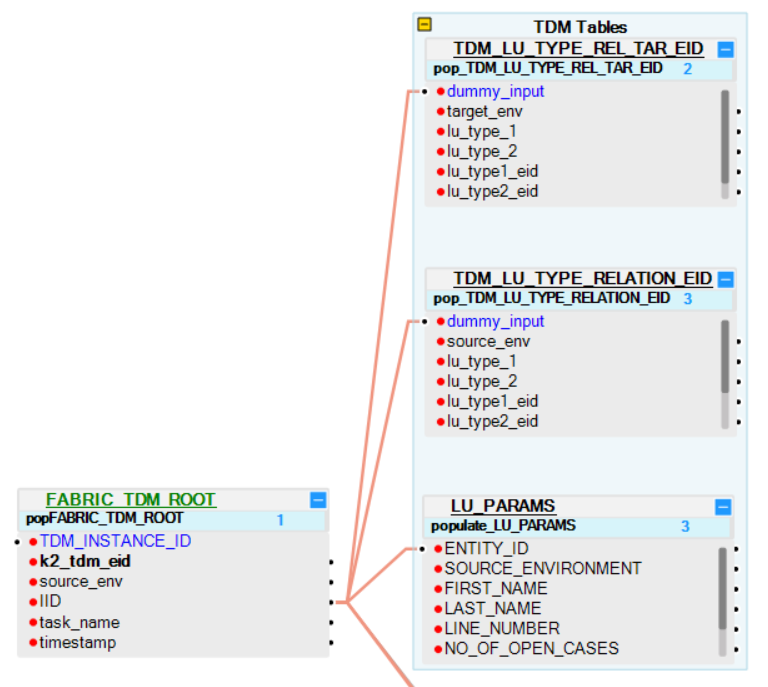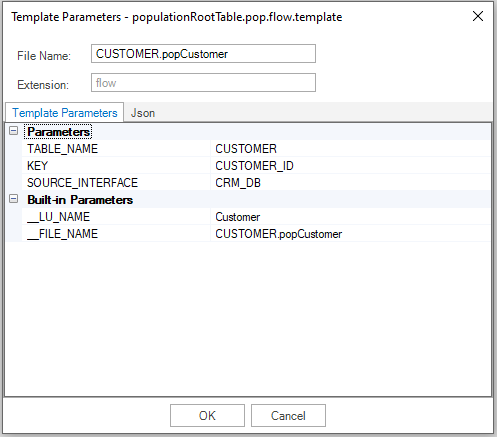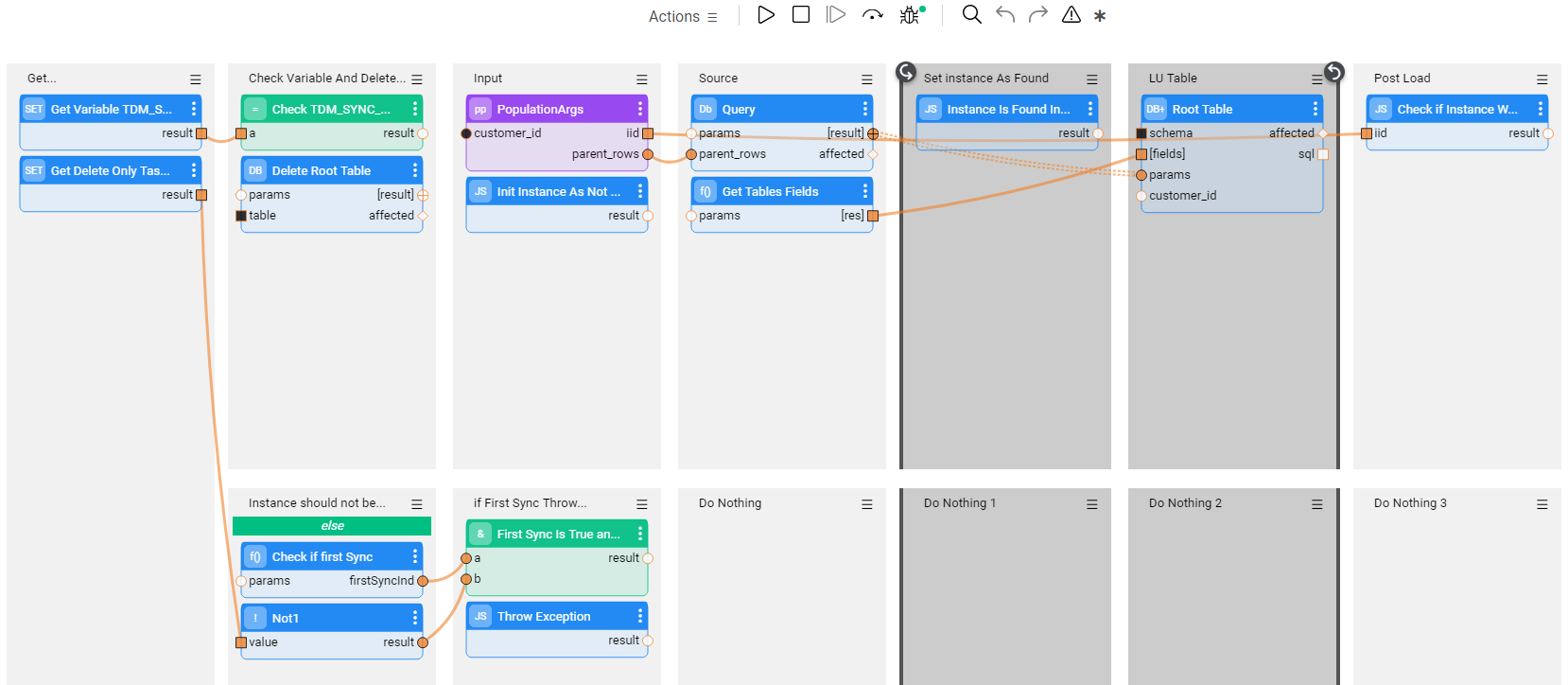TDM LU Implementation - General Guidelines
A TDM task copies a Business Entity (BE) from a source environment to a target environment. A BE can have multiple LUs with either a flat or a hierarchical structure. For instance, a Customer BE consists of Customer Care, Billing, Ordering and Usage LUs. The ability to break a BE up into several LUs enables maximum flexibility and avoids duplication of development. Additionally, defining a hierarchical structure of parent-child LUs enables creating LUs, based on the natural root entity of the related data sources, instead of forcefully setting unified root entities on all LUs related to a given BE.
Each LU in a TDM project should have additional components in order to support TDM functionalities, as described below:
Basic LU Structure
Each LU in a TDM project has the following structure:
Dummy root table, FABRIC_TDM_ROOT.
Generic TDM LU tables that are linked to the root table.
Two main branches that are linked to the root table:
Source branch - LU tables that extract an entity's source data. Source LU tables are populated when a TDM task needs to load (insert) entities to a target environment and therefore must extract the source data of these entities.
Target branch - LU tables that extract the target keys of an entity. The keys are extracted from the target environment in order to enable deleting an entity from a target environment if required by the TDM task.
Click for more information about Fabric implementation and deleting entities from the target environment.
Step 1 - Copy the Objects from the TDM_LIBRARY LU into Each LU
Import the TDM_LIBRARY LU from the TDM Library to your project and copy the LU level objects in the TDM_LIBRARY to your LU.
Step 2 - Add the TDM Root Table and the Generic TDM Tables to the LU Schema
- Add the FABRIC_TDM_ROOT LU table to the LU Schema and set it as a Root table.
- Set the Instance PK column to k2_tdm_eid.
- Add the LU_PARAMS to the LU Schema and link the tables to the FABRIC_TDM_ROOT.IID.
- In Parent LUs, add the TDM_LU_TYPE_RELATION_EID and TDM_LU_TYPE_REL_TAR_EID relationship tables to the LU Schema and link the tables to the FABRIC_TDM_ROOT.IID.

Click for more information about supporting hierarchy in the TDM implementation.
- Add the LU_PARAMS LU table to each LU Schema. Note that the LU_PARAMS table must be added to the LU schema although it is not required for defining LU parameters. In this case, the LU_PARAM table holds only the ENTITY_ID and SOURCE_ENVIRONMENT fields.
Step 3 - Add the Source LU Tables to the LU Schema
Link the main source LU tables to the FABRIC_TDM_ROOT table. The main source tables represent the main (root) tables in the data source. For example, the Customer table is the main source LU table of the Customer LU.
Verify that the main source LU tables are also populated in ROOT_TABLE_NAME and ROOT_COLUMN_NAME Globals.
Create the population of the main source LU tables:
Generate a Broadway flow for the LU table population based on populationRootTable.pop.flow template (imported from the TDM Library):
Right-click the table name > New Table Population Flow From Template > populationRootTable.pop.flow. A popup window opens.
Populate the popup window's settings as follows:
- File Name - populate the file name by [LU Table Name].[flow name]
- Parameters -
- TABLE_NAME - populate it by the LU table name. Note that the LU table name should be identical to the data source table name.
- KEY - populate the key to delete the LU table before populating it.
- SOURCE_INTERFACE - the interface name for the source DB query.
Example:

Set the Truncate Before Sync property of the main source LU table to False, as the Broadway flow deletes the LU table before populating it.
Link the remaining source LU tables to the main LU tables, in a way that if the main source LU table is not populated, the remaining source LU tables remain empty as well.
Mask sensitive data in the LU tables by creating a Broadway flow with Masking Actors to populate the LU tables with the sensitive data.
Click for more information about TDM Masking.
Edit trnLuParams and LU_PARAMS in order to enable a subset of entities from selected parameters for this LU.
Click for more information about Handling TDM Parameters.
Step 4 - Add the Target LU Tables to the LU Schema
Define the LU tables in order to extract the target keys from the target environment. These keys are used by the delete flows for deleting an entity from the target.
Link the main target LU table to the FABRIC_TDM_ROOT table.
Add the fnDecisionDeleteFromTarget Decision function to all target LU tables. Note that this Decision function is under Shared Objects and is imported from the TDM Library.
Create the population of the main target LU table based on a Broadway flow. The Broadway flow should set the task's target environment to be the active environment, enabling the selection of target IDs from the target environment.
Link the remaining target LU tables to the main target LU table.
Click for more information about the deleting entities implementation.
Click for more information about deleting entities from a target environment using a TDM task.
LU Debug
The LUI should include the source environment, which should be set as the active environment in Fabric. When running a Data Viewer on the LU to debug its implementation, do either:
- Populate the source environment of the LUI using
_dev_. For example, _dev_1. - Create and deploy a source and target environments to the Fabric Debug server, set the source environment as an active environment in the Fabric Debug server and populate the deployed source environment name in the LUI. For example, UAT_1. Note that the main target LU table sets the target environment to be the active environment.
Populating the Main Source LU Table - Logic
The Broadway flow of the main source LU table is generated based on the populationRootTable.pop.flow template. It deletes and re-populates the main source LU table under the following conditions:
Running an Extract task or a regular Load task (the Data Versioning checkbox is cleared).
The Set Sync Policy task's setting is not set to Do not Sync Source Data to prevent synchronizing the entities from the source system.
Click to view the Override Sync Mode Summary Table.
The source LU tables are not populated by the LUI sync in the following cases:
- The Sync Policy is set to Do Not Sync From Source Data by the user.
- A delete only task.
- A reserve only task.
- A Data Versioning load task: the selected data version is copied from Fabric.
The Broadway flow also validates whether the entity exists in the source table. If the entity is not found in the main source tables, an Exception is thrown and the entity is rejected.
See example of a Broadway flow that populates Customer LU table:

TDM LU Implementation - General Guidelines
A TDM task copies a Business Entity (BE) from a source environment to a target environment. A BE can have multiple LUs with either a flat or a hierarchical structure. For instance, a Customer BE consists of Customer Care, Billing, Ordering and Usage LUs. The ability to break a BE up into several LUs enables maximum flexibility and avoids duplication of development. Additionally, defining a hierarchical structure of parent-child LUs enables creating LUs, based on the natural root entity of the related data sources, instead of forcefully setting unified root entities on all LUs related to a given BE.
Each LU in a TDM project should have additional components in order to support TDM functionalities, as described below:
Basic LU Structure
Each LU in a TDM project has the following structure:
Dummy root table, FABRIC_TDM_ROOT.
Generic TDM LU tables that are linked to the root table.
Two main branches that are linked to the root table:
Source branch - LU tables that extract an entity's source data. Source LU tables are populated when a TDM task needs to load (insert) entities to a target environment and therefore must extract the source data of these entities.
Target branch - LU tables that extract the target keys of an entity. The keys are extracted from the target environment in order to enable deleting an entity from a target environment if required by the TDM task.
Click for more information about Fabric implementation and deleting entities from the target environment.
Step 1 - Copy the Objects from the TDM_LIBRARY LU into Each LU
Import the TDM_LIBRARY LU from the TDM Library to your project and copy the LU level objects in the TDM_LIBRARY to your LU.
Step 2 - Add the TDM Root Table and the Generic TDM Tables to the LU Schema
- Add the FABRIC_TDM_ROOT LU table to the LU Schema and set it as a Root table.
- Set the Instance PK column to k2_tdm_eid.
- Add the LU_PARAMS to the LU Schema and link the tables to the FABRIC_TDM_ROOT.IID.
- In Parent LUs, add the TDM_LU_TYPE_RELATION_EID and TDM_LU_TYPE_REL_TAR_EID relationship tables to the LU Schema and link the tables to the FABRIC_TDM_ROOT.IID.

Click for more information about supporting hierarchy in the TDM implementation.
- Add the LU_PARAMS LU table to each LU Schema. Note that the LU_PARAMS table must be added to the LU schema although it is not required for defining LU parameters. In this case, the LU_PARAM table holds only the ENTITY_ID and SOURCE_ENVIRONMENT fields.
Step 3 - Add the Source LU Tables to the LU Schema
Link the main source LU tables to the FABRIC_TDM_ROOT table. The main source tables represent the main (root) tables in the data source. For example, the Customer table is the main source LU table of the Customer LU.
Verify that the main source LU tables are also populated in ROOT_TABLE_NAME and ROOT_COLUMN_NAME Globals.
Create the population of the main source LU tables:
Generate a Broadway flow for the LU table population based on populationRootTable.pop.flow template (imported from the TDM Library):
Right-click the table name > New Table Population Flow From Template > populationRootTable.pop.flow. A popup window opens.
Populate the popup window's settings as follows:
- File Name - populate the file name by [LU Table Name].[flow name]
- Parameters -
- TABLE_NAME - populate it by the LU table name. Note that the LU table name should be identical to the data source table name.
- KEY - populate the key to delete the LU table before populating it.
- SOURCE_INTERFACE - the interface name for the source DB query.
Example:

Set the Truncate Before Sync property of the main source LU table to False, as the Broadway flow deletes the LU table before populating it.
Link the remaining source LU tables to the main LU tables, in a way that if the main source LU table is not populated, the remaining source LU tables remain empty as well.
Mask sensitive data in the LU tables by creating a Broadway flow with Masking Actors to populate the LU tables with the sensitive data.
Click for more information about TDM Masking.
Edit trnLuParams and LU_PARAMS in order to enable a subset of entities from selected parameters for this LU.
Click for more information about Handling TDM Parameters.
Step 4 - Add the Target LU Tables to the LU Schema
Define the LU tables in order to extract the target keys from the target environment. These keys are used by the delete flows for deleting an entity from the target.
Link the main target LU table to the FABRIC_TDM_ROOT table.
Add the fnDecisionDeleteFromTarget Decision function to all target LU tables. Note that this Decision function is under Shared Objects and is imported from the TDM Library.
Create the population of the main target LU table based on a Broadway flow. The Broadway flow should set the task's target environment to be the active environment, enabling the selection of target IDs from the target environment.
Link the remaining target LU tables to the main target LU table.
Click for more information about the deleting entities implementation.
Click for more information about deleting entities from a target environment using a TDM task.
LU Debug
The LUI should include the source environment, which should be set as the active environment in Fabric. When running a Data Viewer on the LU to debug its implementation, do either:
- Populate the source environment of the LUI using
_dev_. For example, _dev_1. - Create and deploy a source and target environments to the Fabric Debug server, set the source environment as an active environment in the Fabric Debug server and populate the deployed source environment name in the LUI. For example, UAT_1. Note that the main target LU table sets the target environment to be the active environment.
Populating the Main Source LU Table - Logic
The Broadway flow of the main source LU table is generated based on the populationRootTable.pop.flow template. It deletes and re-populates the main source LU table under the following conditions:
Running an Extract task or a regular Load task (the Data Versioning checkbox is cleared).
The Set Sync Policy task's setting is not set to Do not Sync Source Data to prevent synchronizing the entities from the source system.
Click to view the Override Sync Mode Summary Table.
The source LU tables are not populated by the LUI sync in the following cases:
- The Sync Policy is set to Do Not Sync From Source Data by the user.
- A delete only task.
- A reserve only task.
- A Data Versioning load task: the selected data version is copied from Fabric.
The Broadway flow also validates whether the entity exists in the source table. If the entity is not found in the main source tables, an Exception is thrown and the entity is rejected.
See example of a Broadway flow that populates Customer LU table:





